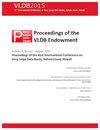构建实时DBMS的技术和效率
IF 3.3
3区 计算机科学
Q2 COMPUTER SCIENCE, INFORMATION SYSTEMS
引用次数: 0
摘要
本文介绍了十多年来开发Aerospike(前身为Citrusleaf)的各种技术,Aerospike是一种实时DBMS,用于世界上一些要求最高性能和可用性的大型关键任务系统。这样的关键任务系统有许多要求,包括在严格的实时SLA(毫秒级)内做出决策的能力,没有停机时间,可预测的性能,以便第一个和第十亿个客户获得相同的体验,扩展10倍(甚至100倍)的能力,没有停机时间,支持需要它的应用程序的强一致性,具有全局事务功能的同步和异步复制,以及在任何公共和私有云环境中部署的能力。我们描述了如何使用有效的算法来优化DBMS的每个领域,以帮助系统实现这些严格的要求。具体来说,我们描述了在一组节点上分片、放置和定位数据的有效方法,集群成员和集群变化的有效识别,使用“智能”客户端产生的效率,如何有效地使用双副本复制而不是三副本复制,如何通过结合使用内存和闪存来降低实时数据占用的成本,自我管理集群以方便操作,包括弹性扩展,网络和CPU优化,包括多线程的NUMA固定。本文描述的技术和效率已经使数百个部署的数量增长了许多个数量级,并且几乎完全正常运行。本文章由计算机程序翻译,如有差异,请以英文原文为准。
Techniques and Efficiencies from Building a Real-Time DBMS
This paper describes a variety of techniques from over a decade of developing Aerospike (formerly Citrusleaf), a real-time DBMS that is being used in some of the world's largest mission-critical systems that require the highest levels of performance and availability. Such mission-critical systems have many requirements including the ability to make decisions within a strict real-time SLA (milliseconds) with no downtime, predictable performance so that the first and billionth customer gets the same experience, ability to scale up 10X (or even 100X) with no downtime, support strong consistency for applications that need it, synchronous and asynchronous replication with global transactional capabilities, and the ability to deploy in any public and private cloud environments. We describe how using efficient algorithms to optimize every area of the DBMS helps the system achieve these stringent requirements. Specifically, we describe, effective ways to shard, place and locate data across a set of nodes, efficient identification of cluster membership and cluster changes, efficiencies generated by using a 'smart' client, how to effectively use replications with two copies replication instead of three-copy, how to reduce the cost of the realtime data footprint by combining the use of memory with flash storage, self-managing clusters for ease of operation including elastic scaling, networking and CPU optimizations including NUMA pinning with multi-threading. The techniques and efficiencies described here have enabled hundreds of deployments to grow by many orders of magnitude with near complete uptime.
求助全文
通过发布文献求助,成功后即可免费获取论文全文。
去求助
来源期刊

Proceedings of the Vldb Endowment
Computer Science-General Computer Science
CiteScore
7.70
自引率
0.00%
发文量
95
期刊介绍:
The Proceedings of the VLDB (PVLDB) welcomes original research papers on a broad range of research topics related to all aspects of data management, where systems issues play a significant role, such as data management system technology and information management infrastructures, including their very large scale of experimentation, novel architectures, and demanding applications as well as their underpinning theory. The scope of a submission for PVLDB is also described by the subject areas given below. Moreover, the scope of PVLDB is restricted to scientific areas that are covered by the combined expertise on the submission’s topic of the journal’s editorial board. Finally, the submission’s contributions should build on work already published in data management outlets, e.g., PVLDB, VLDBJ, ACM SIGMOD, IEEE ICDE, EDBT, ACM TODS, IEEE TKDE, and go beyond a syntactic citation.
 求助内容:
求助内容: 应助结果提醒方式:
应助结果提醒方式:


